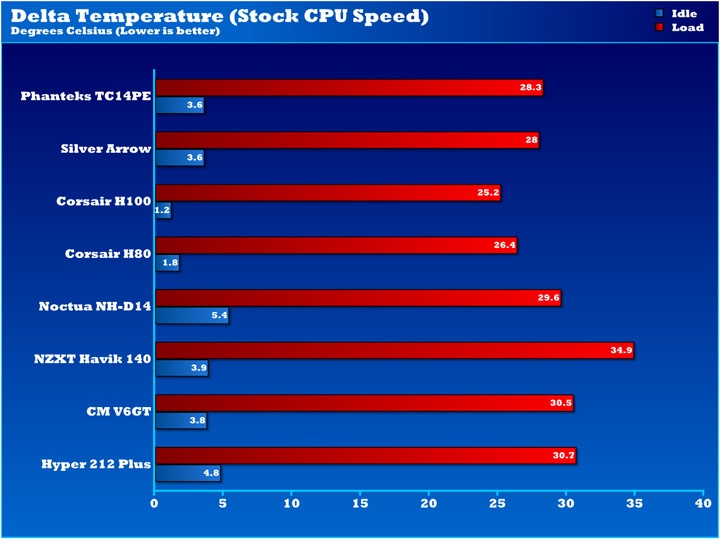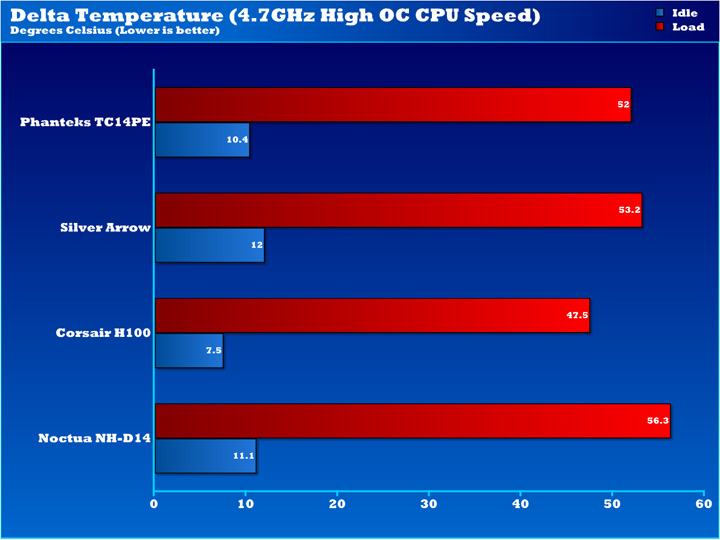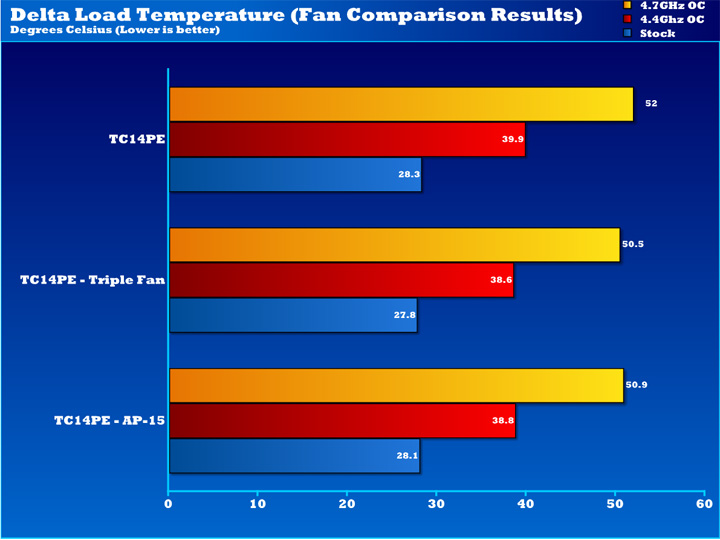Phanteks PH-TC14PE Dual Tower CPU Cooler Review
Luke Hill / 13 years ago
As fierce as the cooling market already is, we enthusiasts always notice room for improvement on our quest to find the elusive perfect cooler. Extra competition usually represents nothing but joy for the consumer’s wallet as multiple manufacturers compete to offer the best bang for your hard earned buck. Cue the market entry for an assassin sent by Phanteks with its targets being the current air cooling kings, from the likes of Noctua and Thermalright and its objective of becoming the most dominant air cooler on the market, bar none!
You can query any enthusiast on what they believe to be the best CPU cooler currently available for consumer purchase. The pair of dual tower brutes clinching the top two results in terms of popularity would probably be the mighty Noctua NH-D14 and Thermalright Silver Arrow. For a long time now, these two monsters have been widely regarding as the best there is where air cooling is concerned but can Phanteks with their dual tower PH-TC14PE CPU cooler change this ageing trend?
The PH-TC14PE features a unique design in so many ways. It is one of the few coolers that has been designed to pack the conduction might of 5 double ended 8mm copper heatpipes departing the copper base for a dual tower aluminium fin array. That is some extreme conduction and heat extraction muscle for a single CPU cooler. The unique features don’t stop there though. Phanteks have their own patented designs for helping them to avoid unintentional nose-dives in cooling performance. P.A.T.S (Physical Anti-oxidant Thermal Shield) which has been successfully proven in the aviation industry and C.P.S.C (Cold Plasma Spraying Coating) technology are just some of the potentially useful and truly unique features designed to improve the cooling performance and thermal conductivity of the PH-TC14PE. Where other manufacturers fall short and overlook such an important aspect of any CPU cooler, the fan, Phanteks haven’t. They have made sure to include two of their high quality PH-F140TS Maelström Vortex Booster 140mm fans ensuring the potential heat extracting prowess isn’t disappointingly wasted by a lack of airflow.
With a red, blue, orange and standard (frosty white in colour) designed cooler being sold by Phanteks, the aesthetics are basically faultless. This is useless without the obligatory performance accompanying those tremendous looks, so let’s waste no more time and explore the performance of this colossal CPU cooler.
Packaging
The front of the PH-TC14PE’s box features a similar styling to that of which we saw when we took our first look at Phanteks with their PH-F140TS 140mm fans. The grey, black and white swirls make for an eye-catching design with glimpses of the 4 different coloured coolers available.
Moving on to the rear of the box, just as featured on the packaging of their 140mm fans, we see an advertising statement regarding the cooler in 10 different languages. The statement outlines some of the key features such as P.A.T.S and C.P.S.C technology.
The left panel is home to the key features and their allocated description as well as information about the mounting compatibility and thermal paste included; Phanteks’ own PH-NDC thermal compound.
An enormous list of specifications is present on the right side of the box. Information about the 171mm maximum height, 1250g weight and 5 year warranty are always welcomed to aid the consumer in their purchase decision.
The Intel “SoliSku” mounting kit consists of a thick and sturdy backplate including a pre-attached LGA 775 rubber spacer along with the necessary spacers, screws and clamps.
The AMD mounting kit features two brackets and the necessary screws and washers.
Phanteks supply a vast accessory package featuring 6 wire fan clips, 12 fan clip adapters, 6 anti-vibration rubber bars, 16 rubber acoustic dampers, a quiet speed adapter (Q.S.A.), 1 ‘Y’ fan splitter, a tube of their PH-NDC nano diamond thermal paste and the cooler’s mounting bar.
Two double-sided, lengthy and informative user manuals are provided, one for French and German speaking users, the other for Spanish and English speaking users.
A Closer LookThe first thing you will most definitely notice when removing the PH-TC14PE from its packaging is their sheer size and weight of the cooler. The dual tower mammoth weighs in at a whopping 970g without fans installed.
If the size was noticed first, the next thing that will smack you in the face is most definitely the sleek, stylish and unique colour scheme of every cooler. Blue, red, orange, frosty white, they all look brilliant!
It is a pleasure for the eye to view such elegant coolers for once. Will Phanteks be the brand leading the way to the days of banishing the release of ugly coolers? If so, we wouldn’t complain.
Every single part of the fin array is coloured in the vibrant coating even the bottom. We really hope this focus on enthusiast grade quality continues into the performance section of our review.
The 5 nickel-plated copper 8mm heatpipes each enter the fin array with identical distances between them. This, coupled with the smooth nickel-plated copper base should allow for the heat load to be spread evenly between the heatpipes for maximum heat extraction and dissipation.
With the 140mm fans mounted, the TC14PE becomes a wide cooler, very wide, even more so when a triple fan configuration is used.
Almost every part of the fin array is able to receive airflow thanks to the large 140mm fans used. The fans extend below each tower which should also help to provide some incidental airflow for VRM and motherboard component cooling.
Phanteks have embossed their brand name into the top of each cooling tower and on two sides of the fan.
The dual 140mm fans follow the same strict colour scheme as their heatsink counterpart. A smooth white frame coupled with 9 MVB designed blades ensures they don’t squander the aesthetic appeal. You can read more about the Phanteks PH-F140TS fans in our specific review of them here.
InstallationThe first task we chose to undertake was fan installation. This required you push 4 fan clip adapters through their respective holes before threading the ‘hook’ design of the fan wire clip through their small gap. This was a difficult procedure first time around which did get easier but a simpler method would definitely be appreciated.
While the fan installation method is fine for the most part, certain fans can’t use the plastic fan clip adapters. A few minutes of creative thinking later and we decided to use the old trusty zip-ties which proved to work very well.
Readying the Intel backplate is just a case of pushing the required screws through their specific holes then inserting their departing ends through the holes in your motherboard.
A plastic spacer sits on the motherboard covering the outside circumference of the screw.
The two strip adapters sit on the plastic space avoiding contact with the motherboard. The socket screws extend through holes in the strip adapters where you can then firmly screw everything together ready for the cooler to make an appearance.
The mounting plate with spring loaded screws attaches to a hole in the centre of the top of the cooler’s base. Provided you own a long screwdriver, you shouldn’t run into any problems here with your first installation. The screw attaching the mounting plate to the cooler though is made of fairly weak metal making the screw head easy to round which is not good if you actually want to be able to remove the cooler.
Simply screw the two spring loaded screws onto their strip adapter targets and the cooler is securely mounted.
Be sure you have plenty of clearance with tall VRM heatsinks on the upper border of your motherboard as this piece of kit is wide!
Anti-vibration rubber strips fit into specially designed channels on either side of the tower’s face. These should help keep noise levels to a minimum.
RAM clearance is surprisingly good thanks to the flexible fan mounting method. If you own tall RAM such as Corsair Vengeance modules, you can simply lift the fan and clip it to the heatsink at a higher location.
Let’s just take a moment to view how exquisite the frosty white TC14PE looks when mounted upon our MSI P67 motherboard.
Make sure that you have a large and wide case as this beast isn’t sparing any room. It engulfs the majority of the upper half of our motherboard. Any cables that need connecting, do so before mounting this cooler or prepare to wriggle your hands into tiny gaps.
With the 120mm Scythe AP-15 fans mounted, the looks aren’t as attractive due to the fan’s quite frankly ugly design and multi-coloured cable. Using 120mm fans also means you lose the use of the anti-vibration rubber strips as the 120mm form factor won’t extend far enough towards the heatsink edges.
A full system shot provides a fitting end to one of the most painless installation procedures one could wish for.
As far as installations go, it was very surprising how easily and quickly we actually completed it. The fan clip connection method is slightly tricky, but nothing too significant. We were annoyed to see the use of weak headed screw holding down the mounting plate. The screw head deformed almost to the point of no salvation meaning we needed assistance from a pair of pliers to tighten and loosen it. We would advise you to take care when attaching this screw because in all fairness, the manual does warn about over tightening. Another surprise was the quality of the instruction manual. As with so many products these days, we expected the English manual to be written in Chinglish or some other confusing language, thankfully, it wasn’t and was very clear.
Test ProceduresWe decided to compare the Phanteks PH-TC14PE against some of the biggest and best CPU coolers from the likes of Noctua, Thermalright, NZXT and Corsair.
Testing method:
- Stable recorded CPU temperatures from a 15 minute idle test
- Stable recorded CPU temperatures from a 15 minute load test
- We repeat the tests using a 4.4GHz, 1.240V overclock and, if the coolers can handle it, a 4.7GHz, 1.340V overclock
- The cooler’s fans are set at 100% speed unless otherwise stated
- All tests are repeated to check the consistency and reliability of the results
- Delta temperatures are used in the charts to provide more accurate results
- Maximum recorded noise output at 100% fan speed
- The supplied thermal paste is always used to make the results a fair interpretation of the cooler’s stock performance
- The temperature threshold we set before calling the test a fail is 65oC above ambient but if the cooler manages to complete more than 75% of the test before rising above the 65oC delta mark, we allow it to complete the test, provided it is capable
- A +/- 1 degree Celsius margin of error is incorporated by our CPU/GPU temperature recording method
- A +/- 0.1 degree Celsius margin of error is incorporated by our ambient temperature recording method
Test system:
- MSI P67A-GD65
- Intel Core i7 2600K
- 4GB Patriot Signature DDR3 1600MHz
- XFX Radeon HD 4870 1GB
- 128GB Kingston SSDnow V100 (OS)
- Corsair TX650
- NZXT Phantom Case
- Supplied Phanteks PH-NDC nano diamond thermal paste
Comparison used:
- Noctua NH-D14
- Thermalright Silver Arrow
- Corsair H80
- Corsair H100
- NZXT Havik 140
- CoolerMaster V6GT
- CoolerMaster Hyper 212 Plus
- Phanteks PH-TC14PE using Scythe AP-15 fans
- Phanteks PH-TC14PE using a triple F140TS fan configuration
Software used:
- Windows 7 Professional 64-bit
- HWMonitor
- Prime95
Stock CPU TemperatureMeasuring temperatures is all about being consistent; therefore we make sure that the test is kept completely fair so that none of the coolers are at a disadvantage. We measure the CPU temperature using HWMonitor after a 15 minute idle period. We then measure the CPU temperature using HWMonitor after a 15 minute load period using Prime95 with the small FFTs setting.
The chart shows the delta CPU temperature (difference between ambient temperature and recorded CPU temperature). This way we can fairly compare each cooler without presenting any inaccuracies due to slight fluctuations in the ambient temperature or unfair results.
Here is an example of how to understand delta temperatures. “If the ambient (room) temperature is 25C and the recorded CPU temperature is 65C, the delta temperature is the CPU’s temperature rise above ambient temperature, therefore the delta temperature in this case would be 40C. If the ambient temperature is 23C and the recorded CPU Temperature is 80C, the delta temperature in this case would be 57C. Delta temperature = Recorded CPU temperature – Ambient temperature”
The PH-TC14PE makes a promising start managing to beat all of the air cooler but the might Silver Arrow in the load test. The difference between the Silver Arrow and PH-TC14PE’s performance is a very small 0.3oC meaning that this results can be considered a draw. The AIO liquid coolers from Corsair prove to be very tough competition due to the fact that the H100 uses a 240mm watercooling radiator to cool its liquid coolant and the H80 has the ability to use external air equal to the ambient temperature.
4.4GHz Overclocked CPU TemperaturesWe repeated the testing procedures with our Intel Core i7 2600K CPU overclocked to 4.4GHz using a BIOS voltage of 1.240V which crept up to a maximum of 1.288V under load conditions. This is a static overclock meaning that the CPU will constantly operate at 4.4GHz. We must remind you that we have recently discovered our processor runs slightly hotter than usual, but seeing as all tests use the same CPU, the results aren’t biased.
With the higher heat output as a result of the increased 1.288V CPU core voltage, the Phanteks cooler starts to pull ahead of the air cooling pack. The 5 8mm heatpipes are starting to work their heat conduction wonders now that the heat output has risen and the air cooling competitor’s heat extraction methods are starting to saturate. Again though, the Hydro series coolers prove very stiff competition.
4.7GHz Overclocked CPU TemperaturesWhen we observe the facts these cooling ‘big boys’ are eating the 4.4GHz overclock for breakfast (albeit while getting heartburn by lunch), we decided there was need for an even higher overclock to separate the men from boys, the high end from the extreme, the failures from the champions.
With our goal to provide realistic results of what end users are likely to be able to achieve and successfully run with their processors, we decided a dynamic 4.7GHz overclock was a great frequency to aim for. Upping the 2600K CPU core voltage to a BIOS set 1.340V which peaked at 1.40V under load conditions, this would be perfect for testing the overclocking headroom available with these heat dissipation monsters. The idle temperature will remain low due to the dynamic overclock’s ability to decrease the multiplier under low CPU load condition. This is different to our static 4.4GHz overclock.
Firstly we regret to say that we were unable to show the Corsair H80 CPU cooler’s results at this frequency due to an absence of the required data.
Now that the heat is really turned up we see the PH-TC14PE’s results produce clear daylight between the results of its Noctua and Thermalright air cooling competitors. Depicting a load temperature result of 52oC above ambient, the Phanteks PH-TC14PE is perfect for 24/7 use at high frequencies and CPU voltages such as the ones tested here. The P.A.T.S and C.P.S.C technologies seem to be doing the trick here as Phanteks have the best performing dual tower air heatsink currently on the market according to our results. What is even more impressive is that the Phanteks cooler has on average, the lowest fan RPM of all four of the contestants. In all fairness, every cooler tested here shows decent enough performance to be considered for 24/7 use, but as always, the cooler the better.
Multiple Fan Configuration TemperaturesWe will repeat the load tests with our CPU at stock speed and overclocked, but this time we will use high powered 1850RPM Scythe AP-15 fans in push-pull configuration. This test will show the heatsink’s true potential with fans that perform excellently on heatsinks and radiators. It will also outline whether or not the bundled fans are offering acceptable performance. Since Phanteks’ PH-TC14PE supports the use of triple fan configurations, we will also test the cooler using three Phanteks PH-F140TS 140mm 1200RPM fans.
We can see that the heatsink offers decent performance when dual 1850RPM Scythe AP-15 fans are equipped. Just over 1oC is shaved off the CPU temperature with both overclocked tests. The triple fan configuration also offers a performance increase, sporting the lowest CPU temperature and best cooling potential of all 3 fan configurations.
Passive CPU TestThroughout testing we observed the cooler’s performance while using very low speed fans which operated at 1200RPM. For it to offer such impressive cooling results while using these fans we couldn’t help but wonder how far we could take this cooler using no fans at all. So, yes, you guessed, we will now show you the results of our testing using the Phanteks PH-TC14PE as a passive CPU cooler.
The test results will be strictly pass or fail. The case fan speeds are set to maximum to ensure that the cooler isn’t choked and starved of air. The temperature threshold we set before calling the test a fail is 65oC above ambient but if the cooler manages to complete more than 75% of the test before rising above the 65C delta mark, we allow it to complete the test, provided it is capable.
Stock Frequency – PASS
4.4GHz Frequency – PASS
4.7GHz Frequency – FAIL
Wow, Just wow! The ability of a dual tower cooler designed to operate with fans to cool a hot 4.4GHz overclock on our hotter than usual Core i7 2600K processor is just amazing. It was very close to the scary heights of 70oC above ambient, but the PH-TC14PE managed to passively cool our stock and 4.4GHz overclocked 2600K CPU. While it did pass the passive test, we would warn you that the temperatures did take a long time to return to normal after removing the Prime95 load. It is possible to run an overclocked CPU passively using this cooler, but we wouldn’t recommend it for extended periods of time where the CPU is susceptible to high load conditions.
AcousticsWhile situated in a room where background noise was kept to a minimum, we placed the sound level meter equal distances from our test system to measure the total noise output by the complete test system for each cooling configuration at 100% fan speed (apart from the passive test).
Here we see that not only does the Phanteks cooler offer excellent cooling performance, it also operates very quietly. While it isn’t as quiet as Thermalright’s Silver Arrow, it does offer better performance for its additional noise output. Our pair of 1850RPM Scythe Gentle Typhoon fans had a slightly higher noise output than usual, which may be due to the fact that they weren’t sat upon the anti-vibration rubber fan strips hence transferring their vibration to the cooler’s metal and producing additional noise. Focusing on the acoustic levels of Corsair’s Hydro series coolers, it is clear to see why they offer such good cooling performance with the dual 2600RPM fans. The choice is yours, better performance with an AIO liquid CPU cooler or much lower acoustic levels with a dual tower air cooler? I know exactly which option I would choose.
Final ThoughtsAs far as cooling potential goes, the Phanteks PH-TC14PE has it in abundance. Throughout testing it traded blows with the biggest and the best CPU coolers and for the most part, ended up leading the way. Considering the competition consisted of heatsinks from brands who have firmly established their place in the list of competitive and well respected cooling companies it is a testament to the engineers at Phanteks who targeted the air cooling performance crown from the start with their first ever consumer CPU cooler. Phanteks’ patented P.A.T.S and C.P.S.C technologies clearly delivered on their marketing hype. The performance results may be somewhat trailing in comparison to the Hydro series All-In-One liquid coolers from Corsair, but considering that those competitors use dual fans which spin at over double the RPM of the Phanteks fans and can sound like a jet engine is inside your computer, the performance compromise may well be very worthwhile. That is something which only you can decide.
Let’s move on to aesthetics. Do they even need explaining? Weighing in at just under a kilogram for the heatsink alone and sporting a dual tower design which extends the cooler to over 15cm wide when fans are attached, it could have been so easy for Phanteks to ignore the aesthetic appeal and just accept defeat with an ugly cooler. Thankfully, this isn’t the strategy they took. As we all know, the style and looks of each component in a modern computer is becoming more popular than ever. Enthusiasts demand the best there is to offer in terms of appearance and are willing to go to extreme lengths to achieve that. Phanteks realised this and designed some of the most attractive CPU coolers you are ever likely to witness. They all feature vibrant, bright and elegant designs which don’t stop in locations where they think we might not notice. To see companies going to these kinds of lengths so that every consumer can be satisfied with the appearance, not just performance of their product is remarkable.
Installation was simple for the cooler itself. Simply attach the backplate, secure the mounting strips, apply thermal paste and attach the cooler. Quick and easy just like it always should be but a lot of the time isn’t. The instruction manual was accurate, easy to follow and to my surprise lacked the spelling mistakes and grammatical errors which we have become accustomed to. Fan installation wasn’t quite as straightforward as the cooler itself, a little practise and some muscle made the procedure much easier and less time consuming. The installation was very secure thanks to the SoliSku mounting kit.
Compatibility of the PH-TC14PE is excellent provided you use a case large enough to house it and ensure it has the motherboard clearance demanded by such a large heatsink. All modern Intel and AMD CPU sockets are supported. RAM interference is kept to a minimum by the fan mounting method which allows users to mount the fan as high on the heatsink as they desire. If you have extremely tall RAM modules, it is possible to manoeuvre the fan so enough clearance is provided, but this may impact the cooling performance due to air not being directed in the desired locations. The ability to use other fans with the TC14PE heatsink comes down to the design of such fans. Our Scythe AP-15 fans needed a few zip-tie modifications but the fan wire clips attached them to the heatsink without hassle.
Acoustic performance is pleasantly good considering the cooling dexterity on display. The dual 1200RPM fans offer what we would consider to be a good compromise between cooling potential and quiet operation. Of course, if you are more of an extreme overclocker, you can always attach your own high powered fans allowing even more of the heatsink’s potential to be unlocked, or vice versa, if you prefer low noise, you can use the supplied quiet sound adapters to throttle fan speed to 900RPM.
With an expected launch day retail price of £69.99 for the standard frosty white colour edition and £72.99 for the coloured editions, this cooler is by no means cheap. A 5 year warranty makes the sum a little easier and more reassuring. Then again, these are only launch prices so expect special offers and price reductions as retailers compete for your hard earned money. Even at the price point of around £70 which has been dominated by the Noctua NH-D14 for so long, we can see the Phanteks PH-TC14PE being an incredibly popular contender in the high end cooling market and rightly so.
So as the assassin leaves its perch to take centre stage, knocking off the Noctua and Thermalright kings who have held the air cooling crown for so long we are left with just one thing to say; the king is dead, long live the king!

.jpg)
.jpg)
.jpg)
.jpg)
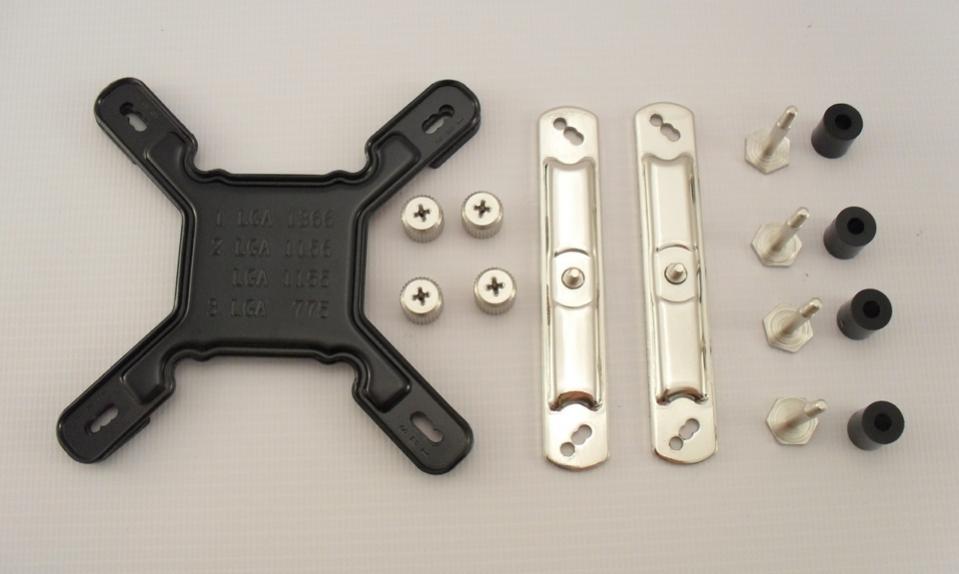
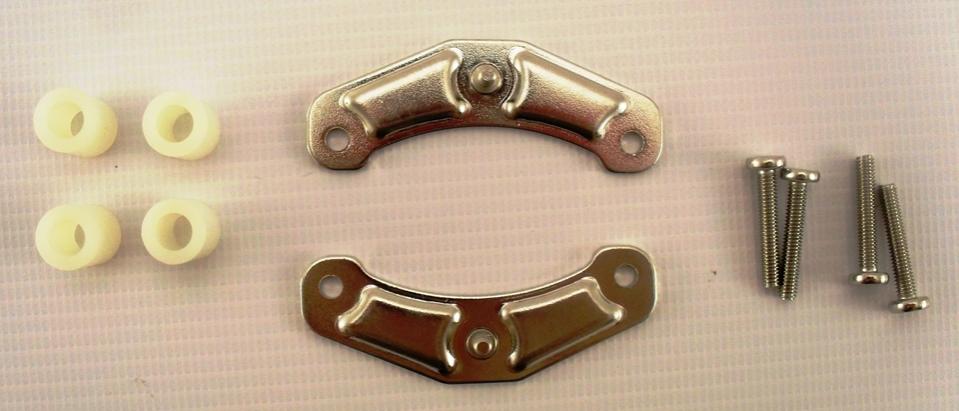
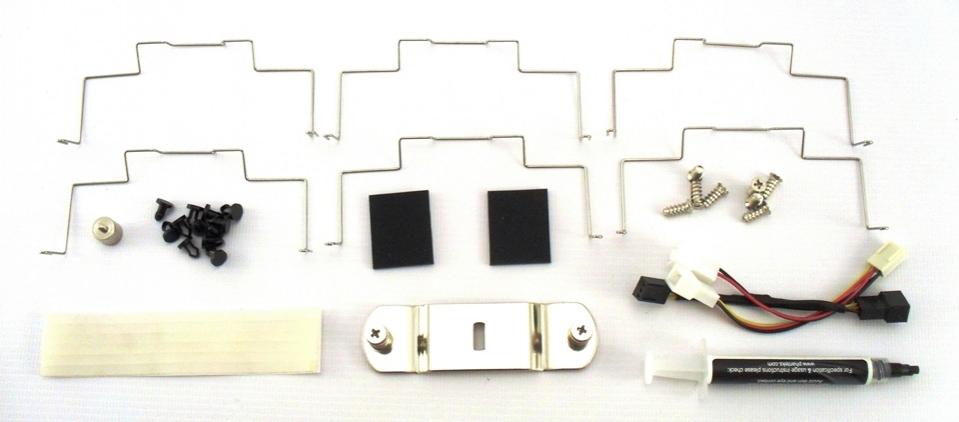
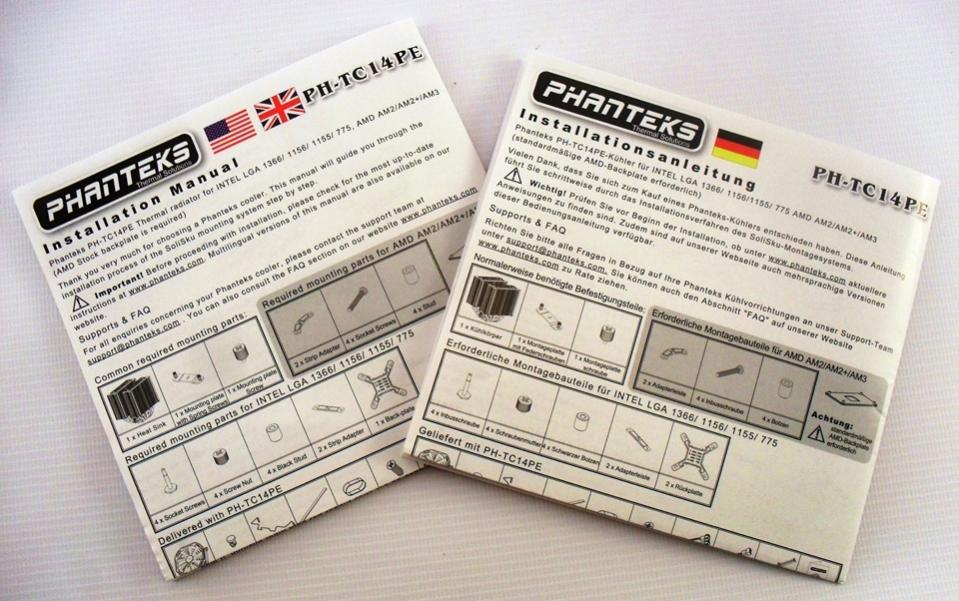
.jpg)
.jpg)
.jpg)
.jpg)
.jpg)
.jpg)
.jpg)
.jpg)
.jpg)
.jpg)
.jpg)
.jpg)
.jpg)
.jpg)
.jpg)
.jpg)
.jpg)
.jpg)
.jpg)
.jpg)
.jpg)
.jpg)
.jpg)
.jpg)
.jpg)
.jpg)
.jpg)
.jpg)
.jpg)
.jpg)
.jpg)
